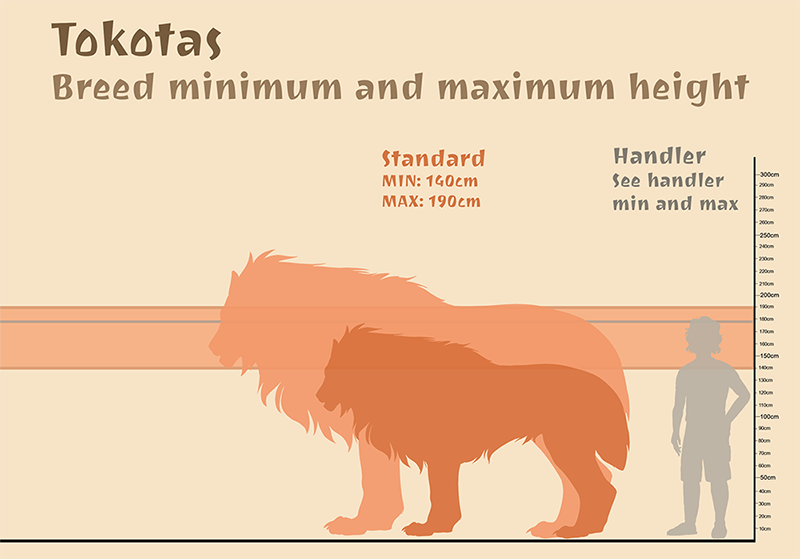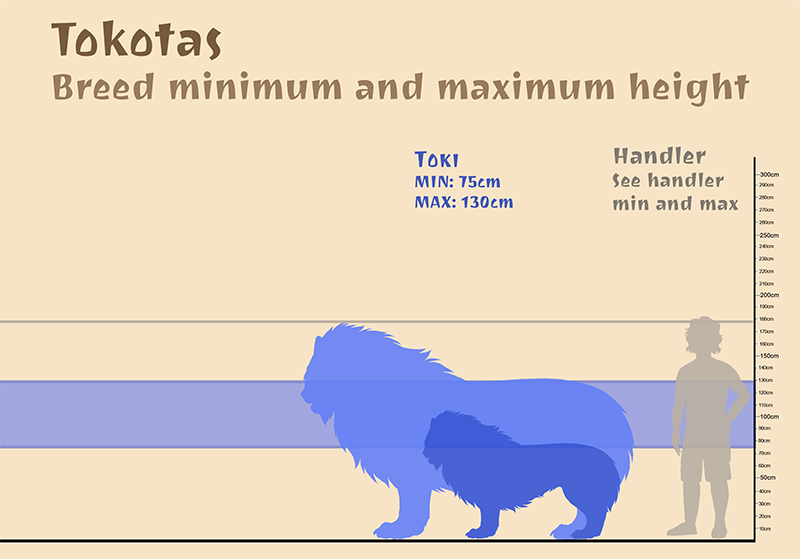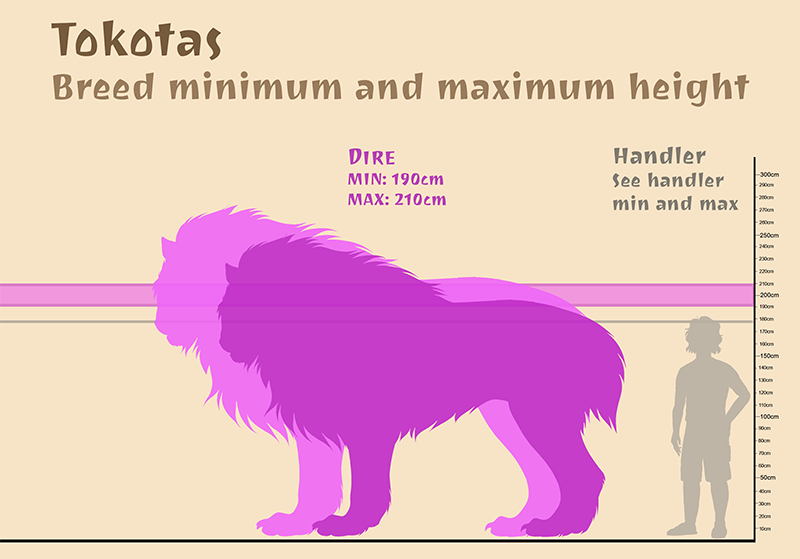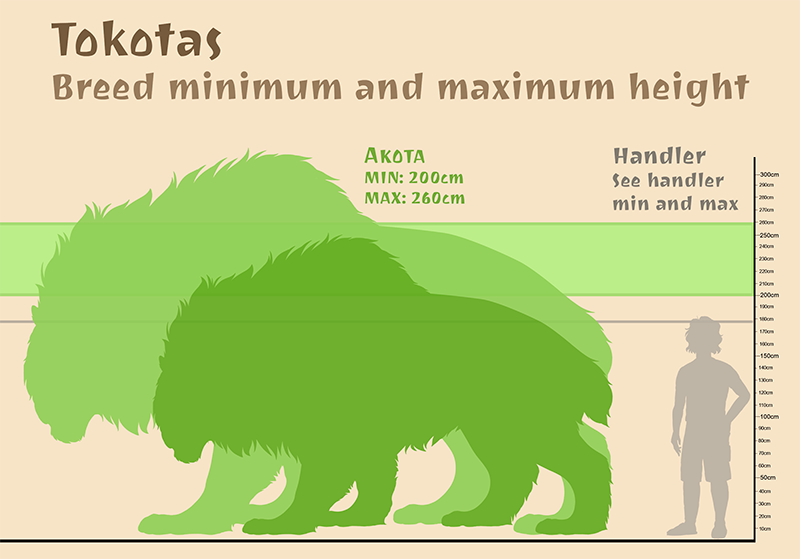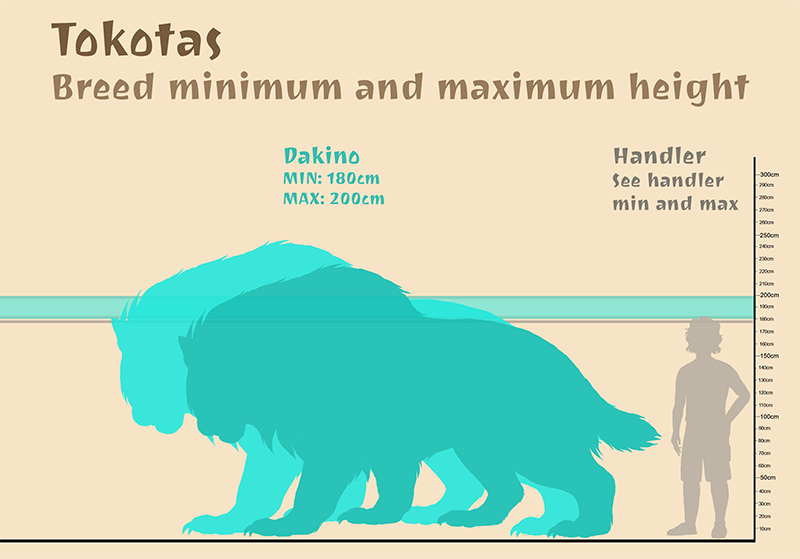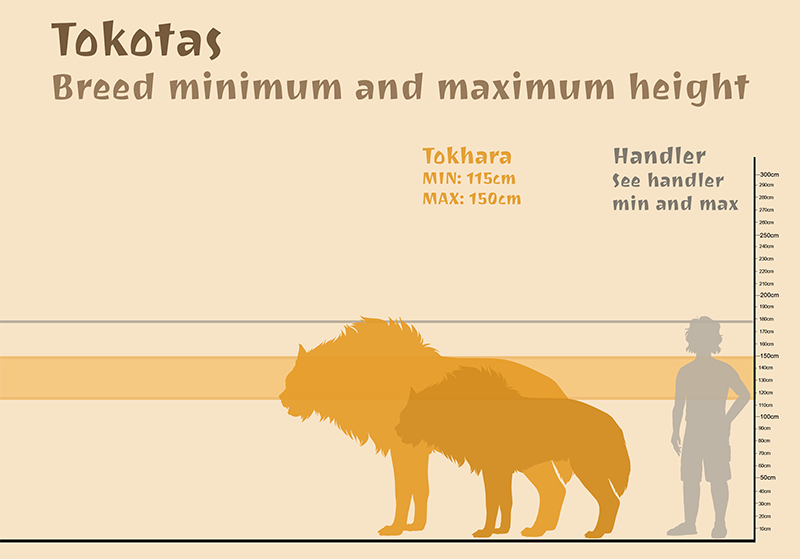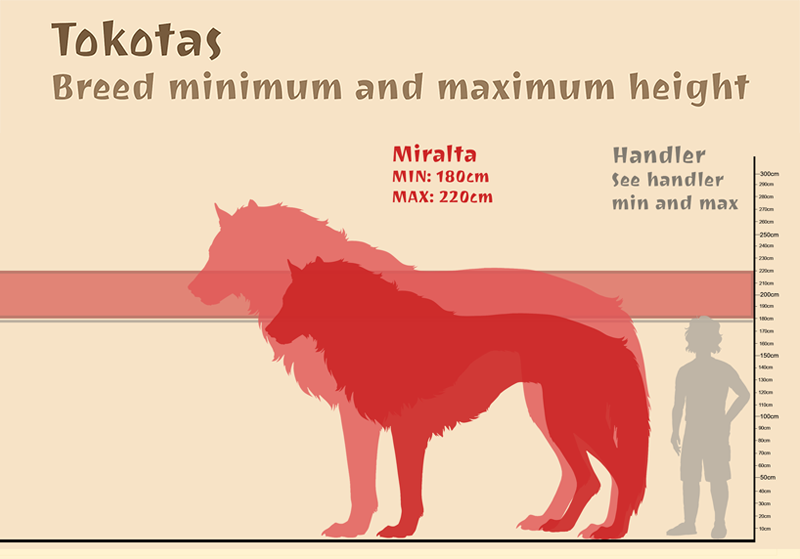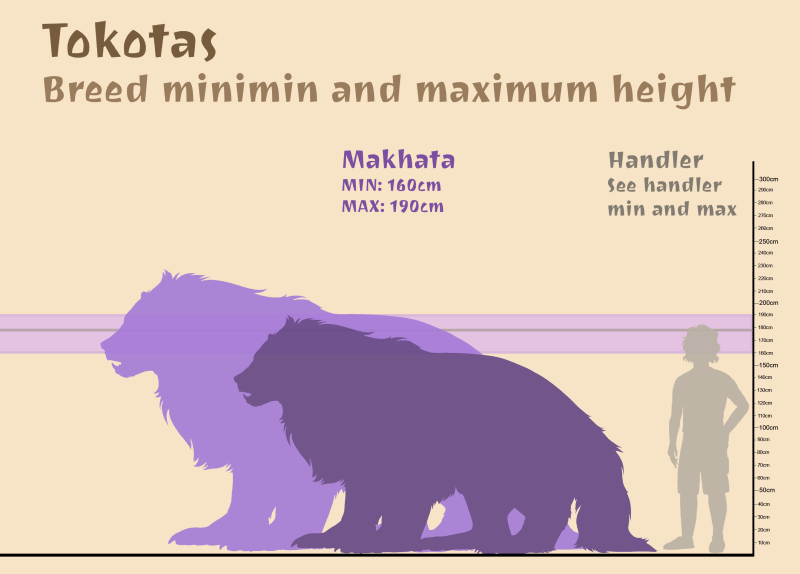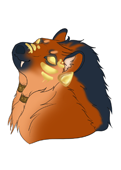Tokopedia
Go to Search
Species Information
Tokota | Toki | Dire | Akota | Dakino | Tokhara | Miralta | Makhata | FAQ
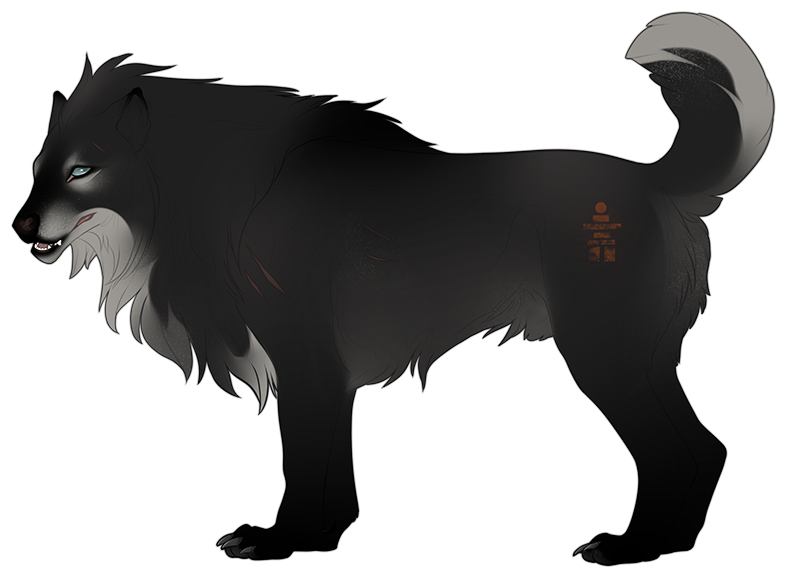
Arguably the most domesticated build, Standards are the “jack of all trades'' of Tokotna, able to carry most riders without issue. They can be trained for a variety of purposes including guarding livestock, plowing fields, performing in shows, or simply being companion animals. Versatile Standards have embedded themselves into the heart of cultures throughout the land as the primary form of the species.
For many beginners looking to introduce Tokotas into their lives, you can never go wrong with the standard Tokota.
Build Group: Standard
Height: 140 cm - 190 cm
Weight: 363 kg - 862 kg
Speed: 80 km/h
Gait: Heavy Trot
Lifespan: 25-30 years domestic, 15-20 years wild
Standard Tokotas have a variety of coat types, but typically they sport a dense undercoat and an outer layer of guard hairs. This is perfect protection against the varied climates to which they have adapted.
The immense versatility of the breed means that variations are not uncommon. However, almost all standard Tokotas retain strong, well-muscled backs. They have deep chests with large hearts and substantial lung capacity. Built for endurance, these heavy creatures can move surprisingly quickly and can easily cover long distances.
Standard Tokotas have an almost unique adaptation which allows them to switch to burning fat in order to replenish their muscle energy stores when running over long distances. The adaptation is present to a lesser extent or entirely missing in other builds, leading to Tokotas being by far the best endurance racers.
Standard Tokotas are incredibly intelligent and able to understand many commands. They can even learn to solve puzzles. Some have learned to unlock and open doors, as well as climb or jump over fences when no one is looking.
Tokotas can be loud and extremely chatty. Like wolves, they communicate with a variety of vocalizations ranging from barks, growls, chuffs and howls. Many claim that standard Tokotas almost appear to ‘talk’ with people.
They are incredibly social in the wild, often observed forming complex and diverse packs. Wild Tokotas tend to be wary of humans and watch their activities from afar. However, even the most feral of wild Tokotas can be reasoned with, given patience and the right treats as bribes of course.
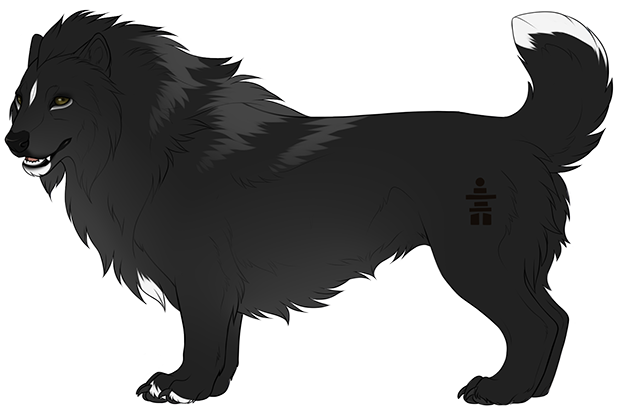
Given their smaller stature, Tokis are often misconstrued as being inherently “gentler” or more domesticated than larger builds. They are most commonly given to smaller children for their first Tokota. Many breed enthusiasts will point out, this is a terrible idea. Tokis are very stubborn and difficult to train. They will not take commands from inexperienced handlers unless highly trained. Socialization at a young age is crucial for a well rounded and adapted Toki.
Tokis have a high prey drive towards small animals and should be kept away from housepets. They are perfectly suited for small game hunting, herding livestock and service animal work. Most work best when given a specific task and can perform many niche jobs that cannot be handled by a standard Tokota.
Build Group: Tiny
Height: 75 cm - 130 cm
Weight: 82 kg - 363 kg
Speed: 40 km/h
Gait: Bouncy Trot
Lifespan: 30-35 years domestic, 12-15 years wild
Toki leg length can vary from smaller than their torso's diameter, to appearing almost like a standard Tokota. With their short legs, Tokis tend to have a bouncy trot and carry their heads relatively high. Unfortunately due to selective breeding for shorter limbs, they are highly susceptible to joint issues and back problems
Tokis have an extra layer of fat all over their bodies. This gives them a deceptively chunky appearance, and someone unfamiliar with their anatomy might call them overweight. But this extra padding is natural and protects them from extreme cold, physical injury and aids them in both swimming and burrowing.
While naturally energetic and having all the hardiness of their larger kin, Tokis are far less suited to endurance racing. Finding suitable outlets for their energy is a requirement when you have a Toki in a small space. Though there are some Tokis who absolutely adore the life of a lapdog, if they grow bored they are prone to be destructive.
Generally, Tokis are similar in vocalizations and intelligence to standard Tokotas. When trained, they are amazing performers of tricks and service based tasks. They make wonderful guard dogs against smaller predators for city homes and farms.
Unlike standard Tokotas, Tokis are less fond of living in large packs. Instead they usually connect to a set few other Tokotas, their own pups, or a single handler. It's uncommon to see Tokis out in the wild, as they did originate as a domesticated breed. Once in a blue moon, one or two might be spotted in the local wild packs.
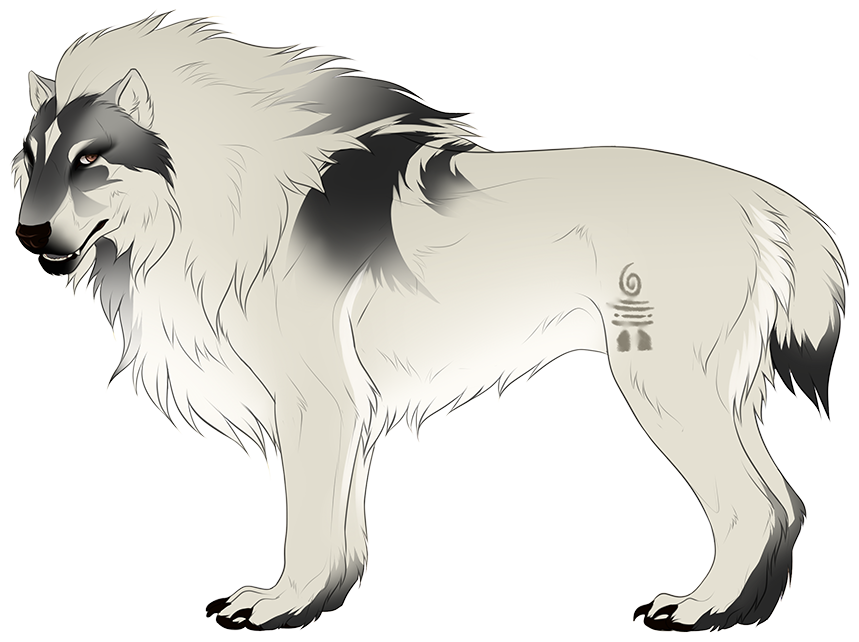
A Dire’s blood content, which is measured in increments between 10% and 100%, directly affects how likely their offspring are to exhibit their distinct appearance. Dires are also the most diverse Tokotas in terms of difficulty to handle, with some lines being largely bred with standard Tokotas to make them more amenable to everyday living.
Dires are the 'warmbloods' of the Tokota species with a respected balance of strength, speed, and stamina. They are ideal companions for hunting large prey, pulling heavy loads, guarding livestock, and use in law enforcement. Most breeders advise not owning a Dire if you have no prior experience caring for and handling a Tokota.
For many years, domesticated Dires have faced stagnation in their breeding pools due to a small high content population. However, further insight into proper training methods and breeding projects has led to a rise in a healthy Dire population.
Build Group: Hefty
Height: 190 cm - 210 cm
Weight: 635 kg - 1089 kg
Speed: 64 km/h
Gait: Steady Lope
Lifespan: 25-28 years domestic, 16-20 years wild
Dires are heavily muscled, but long legged with sharp claws that help them to roam around the mountains and maneuver over rocky terrain. Dire Tokotas move at a slower and steadier pace to conserve energy. Their larger skull has more room for muscle attachment than any other known breed, allowing them to latch on to prey and disable them.
When allowed to partake in a natural diet, Dires are more prone to putting on weight than their neighboring breeds. The padding of blubber they develop from consuming a rich diet of meat and fish is vital to lowering the Dire's litter mortality rate. The sign of an optimally healthy Dire is one with a relatively thick pad of fat between the forelegs to protect and retain heat around the heart and lungs. This can be seen more prominently in Dire puppies, who often get mistaken for legged seals.
Intelligent and strong-willed, Dires can be independent and almost cat-like in their behavior. To train a Dire of any percentage is to convince them that the task presented to them was actually their idea all along. An experienced handler with a solid bond can bend a Dire’s naturally strong instinct drive to great effect. They often have to be ready for ‘presents’ of prey animals if they don't keep the Dire appropriately focused on a task.
Dires are not as loud as the standard Tokota cousins. They have all of the same vocalizations but their register is a lot deeper and gruffer, giving their howls a haunting but elegant timbre.
In the wild, Dires live in family based packs with complex structures of hierarchy. Packs are wary of humans and will not hesitate to chase them from their territory. However, actual maulings by wild Dires tend to be committed by lone, lower percentage individuals, as they are comfortable living closer to settlements.
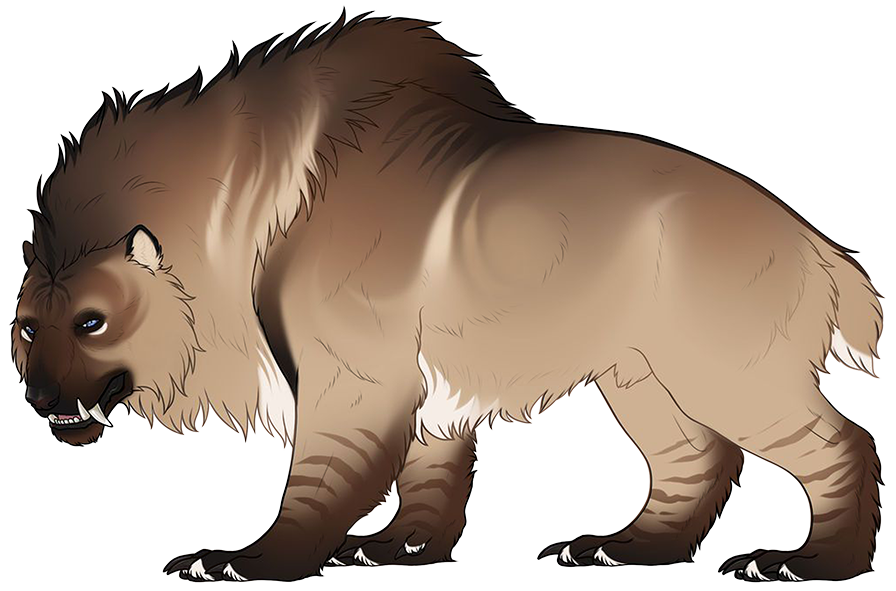
Akotas tower over their masters and display deadly strength if not socialized and trained properly. While possible to tame an Akota, their keepers almost unanimously agree that bonding with an Akota pup born in captivity is the safest way to forge a relationship. Modern breeding practices work to bring the temperament of the Akota in line with that of their Dire cousins, but make no mistake: Akotas are still much more "tamed" than "domesticated".
Unlike their smaller cousins, Akotas do not fall into the pack structures. They do not have the speed or endurance for long distance hunting and have no need for a pack. Instead, Akotas specialize in fishing as their primary source of diet.
Build Group: Hefty
Height: 200 cm - 260 cm
Weight: 680 kg - 1361 kg
Speed: 40 km/h
Gait: Lumbering Walk
Lifespan: 30-40 years domestic, 26-30 years wild
Their dense weight makes it hard for them to sustain any kind of speed for long. However, Akotas can switch from an ambling walk to a surprisingly fast lunge in a matter of seconds to catch targets off guard. They use their entire body during fights with opponents, taking down prey or rivals with brute strength.
Akotas have big, flat paws meant for breaking into dams, ice, and shelter for animals like seals and fish. Coupled with their stocky legs, their build allows for more balance to compensate for their larger size. This adaptation has also given Akotas the unique ability to temporarily stand with just their hind legs, allowing Akotas to deliver full force behind crushing blows from their claws.
Positive, reward based training is the only way to reach and earn cooperation with an Akota. Aggression or training that requires displays of 'dominance' often leads to trouble. A few behaviors to be wary of in any Akota include a swaggering walk, prolonged eye contact, and direct approach. Akotas do have the capacity to be gentle creatures when they do not feel threatened. An Akota that is likely to welcome interaction might be identified by a lack of eye contact or even closed eyes, and stillness without agitated breathing.
People assume that Akotas are less intelligent than their standard Tokota cousins. This is not true as they are clever problem solvers, but often take a direct approach to everything. Part of the reason for this misconception is that Akota have less vocalization sounds than the rest of the Tokota breeds. They are deep chested which gives Akotas access to a unique vocalization, the Roar! Akota roars have been known to stun creatures.
Akotas were long considered the true “solitary'' build of Tokotna, however this claim has been called into question in recent years. While Akotas do not form packs and live independent lives, deep familial bonds have been observed. New research has also shown friendly behavior between unrelated individuals, typically around popular fishing spots. This has led researchers to believe that Tokotas’ sociality might have evolved earlier than previously thought.
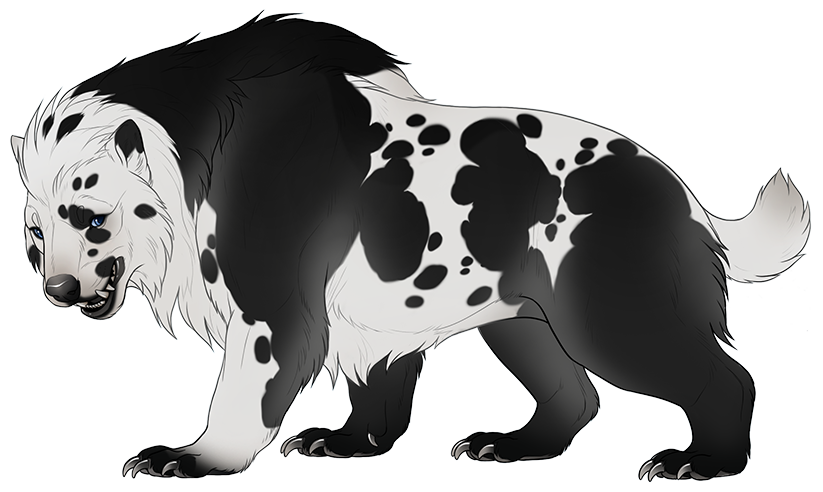
While they may share physical resemblances with Akotas, sometimes being lovingly referred to as “Toy-kotas”, Dakinos have their own unique temperament and abilities. They have a gentle, if mischievous, disposition and are easy to handle. Dakinos have been utilized for everything from companions to heavy labor. Their curved claws are well suited for pursuing burrowing prey, and they have seen a rise in popularity as small game hunters.
Due to nearly every Dakino being raised from birth with a handler the entire breed is considered domesticated and wild Dakinos are rare. Because of this Dakinos are family oriented and do not usually fall into a hierarchy structure. When a Dakino is seen in the wild they are usually accompanied by a pack of Dires or a lone Akota mother.
There is debate with how quickly Dakinos appeared in cross breeding that they may have existed thousands of years ago. Researchers point to when Dires were first appearing alongside Akotas, but there is currently no definitive fossil evidence. Regardless, Dakinos have taken off as a specialty breed for both their unique appearance and their compact size and strength.
Build Group: Modest
Height: 145 cm - 195 cm
Weight: 363 kg - 862 kg
Speed: 32 km/h
Gait: Heavy Amble
Lifespan: 26-30 years domestic, 18-20 years wild
Their build is stocky and keg-shaped, with short legs and flat paws. This combination is not favorable for quick or sustained speed, especially running on inclines. However, a Dakino's curved claws and broad shoulders do afford them other options.
While they might look like awkward hunters, Dakinos have keen noses and are excellent diggers. They are very capable at locating and pursuing underground prey. Their curved claws are also designed for climbing trees, offering wild Dakinos vertical escapes from larger predators and domestic Dakinos the ability to confound their handlers best attempts at containment.
It is advised that domestic Dakinos are kept as part of a household with other Tokotas or animals as they are highly social creatures. Dakinos bond quickly with handlers, and are easy to socialize with other humans. This makes them well suited for urban jobs in draft or scent work. Unfortunately, because they are very loyal and easily tamed, some have taken advantage of the Dakino’s strength and used them in criminal enterprises.
Dakinos have the same vocalizations as their Dire parentage and also inherited a much weaker version of the Akota’s roar. The Dakino Roar is similar to a young lion and is used more for marking territory than actual intimidation. Additionally, due to having a more bear-like jaw their howls are distinct from other Tokota species.
Though rare in the wild, Dakino’s social mentality persists. They can be seen in small packs and form tightly knit groups of four or five individuals.This group will hunt, forage, and share a den together as well. Dakinos will form this group with any breed and even non-Tokota species much like domestic Dakinos.
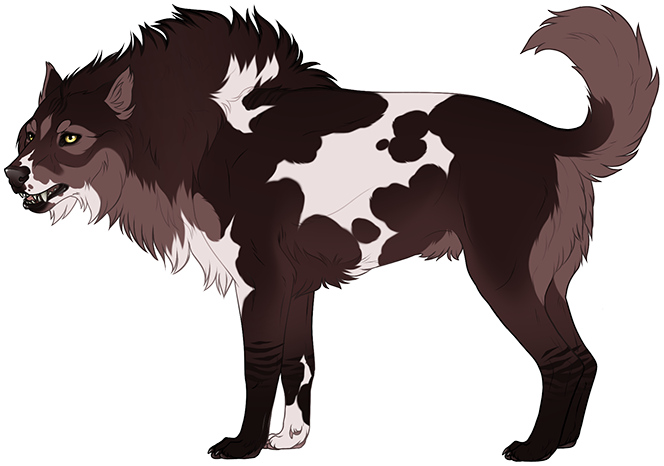
The Vurnma region is the only place in the world to get a domesticated Tokhara. There have been many previous attempts at training, but nothing has panned out until recent years. The majority of the Tokhara population is still wild over multiple regions of Tokotna. Only a small fraction of Tokhara have been bred in captivity and all of those are chipped and licensed.
With spicy personalities and high energy, Tokhara often give their handler far more trouble than they’d bargained for. It is recommended that Tokhara puppies are handled from a very young age by an experienced handler. While highly social creatures, Tokharas will only bond with a single handler and will be aloof with other humans.
Given the difficulty of training Tokharas, they do not see much use in protection or labor work. Most are kept as exotic pets, and Tokhara racing has become a popular sport. There are ongoing efforts to train Tokhara lines for livestock herding, as well as hunting, however their piscivorous natures have complicated efforts.
Build Group: Tiny
Height: 115 cm - 150 cm
Weight: 113 kg - 408 kg
Speed: 100 km/h
Gait: Light Pace
Lifespan: 21-25 years domestic, 18-25 years wild
Lacking the bulky musculature of other breeds, the Tokhara’s lean build trades brute strength for agility and sprinting. Adapted for arid climates, they have enormous lungs and heart compared to their body size. Their arched back allows their heads to rest lower to the ground for easy tracking while on the run. Unlike their cousins, Tokharas are not endurance hunters. They favor a mixture of sprint and ambush hunting during the cooler parts of the days.
After standard Tokotas migrated to the southern regions they evolved in different ways creating the modern Tokhara. They are incredible jumpers, thanks to the unique shape of their skeletal structure which allows them to leap over rivers catching fish in the air. Tokhara jaws are powerful enough to crush bone and can lock in place with a thick inner mouth. Their teeth are proportionately larger than the standard Tokota. Some have even witnessed Tokhara munching on cacti when hungry enough.
They are often described as feisty and hot-tempered, which is not untrue. However, they are also quite sociable, but their gestures of friendship are often mistaken for aggression. Their body language is extremely exuberant and emphasizes physical contact. For example, Tokharas often jump up on each other to encourage play, sharing of food, and to express excitement.
Domesticated Tokharas are SASS machines, they will back chat and dance around their handlers. Tokharas are stubborn, quick-witted, self-motivated, and in many cases problem makers. They are notable for how they often observe situations before choosing what to do. Their attitudes are legendary. Handlers hear a Tokhara long before they see them. Boisterous, social, and as spicy as they come, Tokharas are known for their wide array of different vocalizations ranging from quick yaps to chattering laughter. Their cackle can be heard for miles, leading to the saying “A quiet Hara is a missing Hara.”
Another familiar saying for the Tokhara is “Where there is one Hara, there are many.” Wild Tokharas are very social, banding together in loose confederations for increased survival rates. Even if a lone Tokhara is found they will use their speed to flee quickly from a threat, only to return within minutes with a swarm of backup. Tokhara are competitive with each other as long as they all feel safe. The moment there is an external threat all games and rivalries are forgotten for the safety of the pack.
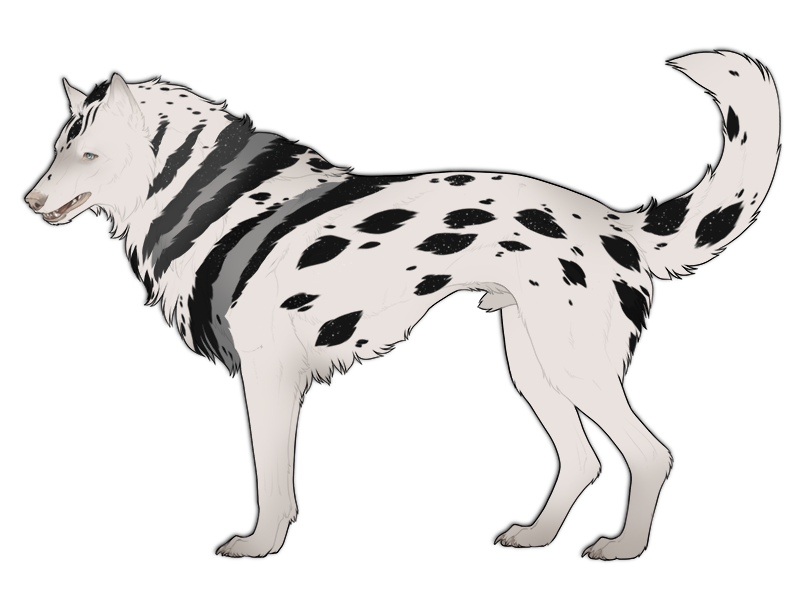
The Miralta is built for endurance; their long legs and lighter frame helps carry them over longer distances than other Tokota species in their size class. This makes them ideal for hunting prey over greater lengths than others, keeping manageable speeds whilst tiring their prey down before finishing the hunt.
Well-trained and socialized Miraltas also make excellent racing, herding, and performing Tokotas. However, they tend to only obey one handler no matter how many humans they are raised around.
They are recommended only to expert handlers for their widely varied temperaments, unreadability, and unpredictability. Owners should not seek out Miraltas for their beauty alone and must understand that they are a world-class working breed with high-energy demands and very specific environmental requirements, including but not limited to: heightened ceilings, taller than average stalls, narrower than average bar rungs and fine/narrow drainage grates where applicable.
Build Group: Hefty
Height: 180 cm - 220 cm
Weight: 446 kg - 605 kg
Speed: 85 km/h
Gait: Cautious Amble
Lifespan: 22-28 years domestic, 14-22 years wild
Like greyhounds, Miraltas’ slim build and light bone structure make them excellent racers. Their nimble feet help them keep their balance in rough terrain and allow them to traverse the thinnest ledges of steep mountains. In plains and grasslands, their long legs give them an advantage while stalking prey from a distance and enable them to see over tall grass and brush.
Their thin frames and strong legs also make them great jumpers. They can jump forward more than three times their length and up nearly twice their height, which allows them to catch low-flying birds and low-hanging fruit.
Due to their low body fat levels, Miraltas are prone to hypothermia and overheating. Longer-coated Miraltas will do better in the cold, but those with a short coats may need a jacket in winter time, and it is recommended to ensure your Miralta has access to shade and plenty of water in summer, regardless of coat type. Please be mindful of signs of heatstroke: excessive panting or drooling, lethargy, and disorientation.
Other traits include a serious nature and a strong prey drive. It is recommended that Miraltas be introduced to as many children, livestock, and pets as possible when they are puppies to avoid issues when they are adults. They require constant exercise or a job to do, or they can become destructive. As such, Miraltas are not considered a good starter breed.
These gentle giants might seem air-headed, but they are very intelligent. A wild Miralta in its natural habitat is almost impossible to catch due to its speed and smarts. While this makes them a great choice for performance- or puzzle-based events, the same trait makes a bored Miralta a problematic Miralta.
Miraltas that survive in the wild spend most of their waking hours hunting and foraging as their preferred diet consists of rabbits, rodents, and fruit. Domesticated Miraltas have a higher chance of becoming overweight as they have no drive to move around when food is readily available. Excess weight causes great concerns for Miraltas due to their long and thin bone structures being unable to carry it. Handlers must ensure that they do not overfeed or under exercise them.
Build Group: Modest
Height: 160 cm - 190 cm
Weight: ? kg - ? kg
Speed: ? km/h
Gait: ?
Lifespan: ?
Tokota

Canarctos venatori
The standard Tokota is the result of hundreds of years of co-evolution and domestication with mankind. They were bred to hunt ungulates on the tundras and forests of Taniya and the Tartoks, and to be protectors and companions. When mankind spread across Tokotna, so too did the standard Tokota. Today they are known for their versatility, endurance, loyalty, and adaptability and are a common sight even far from their native range.Arguably the most domesticated build, Standards are the “jack of all trades'' of Tokotna, able to carry most riders without issue. They can be trained for a variety of purposes including guarding livestock, plowing fields, performing in shows, or simply being companion animals. Versatile Standards have embedded themselves into the heart of cultures throughout the land as the primary form of the species.
For many beginners looking to introduce Tokotas into their lives, you can never go wrong with the standard Tokota.
Build Group: Standard
Height: 140 cm - 190 cm
Weight: 363 kg - 862 kg
Speed: 80 km/h
Gait: Heavy Trot
Lifespan: 25-30 years domestic, 15-20 years wild
Anatomy:
Though most commonly described as a mixture between wolf and bear, standard Tokotas are considered the most lupine of the Tokota species. Their snouts are narrower and longer than most of the canarctos family. They are generally lean and muscular in build with a slightly blocky muzzle and broad chest.Standard Tokotas have a variety of coat types, but typically they sport a dense undercoat and an outer layer of guard hairs. This is perfect protection against the varied climates to which they have adapted.
The immense versatility of the breed means that variations are not uncommon. However, almost all standard Tokotas retain strong, well-muscled backs. They have deep chests with large hearts and substantial lung capacity. Built for endurance, these heavy creatures can move surprisingly quickly and can easily cover long distances.
Standard Tokotas have an almost unique adaptation which allows them to switch to burning fat in order to replenish their muscle energy stores when running over long distances. The adaptation is present to a lesser extent or entirely missing in other builds, leading to Tokotas being by far the best endurance racers.
Behavior:
The standard Tokota is the most domesticated of all the builds. They have a more dog-like demeanor that lends to easy bonding with family and integration with other animals. They are vocal, loving, and hard working which results in them being the best starter breed for young handlers or people simply wanting a Tokota companion.Standard Tokotas are incredibly intelligent and able to understand many commands. They can even learn to solve puzzles. Some have learned to unlock and open doors, as well as climb or jump over fences when no one is looking.
Tokotas can be loud and extremely chatty. Like wolves, they communicate with a variety of vocalizations ranging from barks, growls, chuffs and howls. Many claim that standard Tokotas almost appear to ‘talk’ with people.
They are incredibly social in the wild, often observed forming complex and diverse packs. Wild Tokotas tend to be wary of humans and watch their activities from afar. However, even the most feral of wild Tokotas can be reasoned with, given patience and the right treats as bribes of course.
Toki

Canarctos brevis
As the closest genetic relative, Tokis were once widely considered a dwarf mutation of the standard Tokota. More recent science confirms what many handlers have long suspected: Tokis are a distinct subspecies that evolved over time. They are most notable for their short legs, small build, and big personalities. Tokis are beloved for their adorable, corgi-like waddle.Given their smaller stature, Tokis are often misconstrued as being inherently “gentler” or more domesticated than larger builds. They are most commonly given to smaller children for their first Tokota. Many breed enthusiasts will point out, this is a terrible idea. Tokis are very stubborn and difficult to train. They will not take commands from inexperienced handlers unless highly trained. Socialization at a young age is crucial for a well rounded and adapted Toki.
Tokis have a high prey drive towards small animals and should be kept away from housepets. They are perfectly suited for small game hunting, herding livestock and service animal work. Most work best when given a specific task and can perform many niche jobs that cannot be handled by a standard Tokota.
Build Group: Tiny
Height: 75 cm - 130 cm
Weight: 82 kg - 363 kg
Speed: 40 km/h
Gait: Bouncy Trot
Lifespan: 30-35 years domestic, 12-15 years wild
Anatomy:
Though most commonly described as a smaller standard Tokota, the anatomy for Tokis has varied wildly from centuries of different breeding lines. Tokis generally have shorter snouts, ears, toes, and longer tails relative to their body length, with thick joints. The Toki's compact body and heavy bone structure create a stocky silhouette.Toki leg length can vary from smaller than their torso's diameter, to appearing almost like a standard Tokota. With their short legs, Tokis tend to have a bouncy trot and carry their heads relatively high. Unfortunately due to selective breeding for shorter limbs, they are highly susceptible to joint issues and back problems
Tokis have an extra layer of fat all over their bodies. This gives them a deceptively chunky appearance, and someone unfamiliar with their anatomy might call them overweight. But this extra padding is natural and protects them from extreme cold, physical injury and aids them in both swimming and burrowing.
Behavior:
Although smaller than other Tokota species, Tokis have very big personalities and will often display what is commonly known as "Small Dog Syndrome." This makes them stubborn and standoff-ish towards creatures bigger than them. Most breeders advise Tokis be socialized from an early age to rectify this behavior before it gets out of hand. When properly trained, Tokis are the sweetest pups and absolutely adore to be petted and scratched behind the ears.While naturally energetic and having all the hardiness of their larger kin, Tokis are far less suited to endurance racing. Finding suitable outlets for their energy is a requirement when you have a Toki in a small space. Though there are some Tokis who absolutely adore the life of a lapdog, if they grow bored they are prone to be destructive.
Generally, Tokis are similar in vocalizations and intelligence to standard Tokotas. When trained, they are amazing performers of tricks and service based tasks. They make wonderful guard dogs against smaller predators for city homes and farms.
Unlike standard Tokotas, Tokis are less fond of living in large packs. Instead they usually connect to a set few other Tokotas, their own pups, or a single handler. It's uncommon to see Tokis out in the wild, as they did originate as a domesticated breed. Once in a blue moon, one or two might be spotted in the local wild packs.
Dire

Canarctos dirus
Long considered an ancestor of the standard Tokota, Dires are now understood to be more of a "sidestep" from Akotas. Most modern zoologists point to an extinct common ancestor rather than a direct path between standard Tokotas and Akotas. Dires are one of the largest living subspecies of Tokotas with massive frames and broad heads.A Dire’s blood content, which is measured in increments between 10% and 100%, directly affects how likely their offspring are to exhibit their distinct appearance. Dires are also the most diverse Tokotas in terms of difficulty to handle, with some lines being largely bred with standard Tokotas to make them more amenable to everyday living.
Dires are the 'warmbloods' of the Tokota species with a respected balance of strength, speed, and stamina. They are ideal companions for hunting large prey, pulling heavy loads, guarding livestock, and use in law enforcement. Most breeders advise not owning a Dire if you have no prior experience caring for and handling a Tokota.
For many years, domesticated Dires have faced stagnation in their breeding pools due to a small high content population. However, further insight into proper training methods and breeding projects has led to a rise in a healthy Dire population.
Build Group: Hefty
Height: 190 cm - 210 cm
Weight: 635 kg - 1089 kg
Speed: 64 km/h
Gait: Steady Lope
Lifespan: 25-28 years domestic, 16-20 years wild
Anatomy:
Dires are much bulkier than their standard Tokota cousins. Their skulls are wider and sport longer fangs, smaller snouts with a more prominent roman nose, and smaller ears. The tail on a Dire is also relatively shorter than a standard Tokota, allowing them to not risk injury while hunting large game.Dires are heavily muscled, but long legged with sharp claws that help them to roam around the mountains and maneuver over rocky terrain. Dire Tokotas move at a slower and steadier pace to conserve energy. Their larger skull has more room for muscle attachment than any other known breed, allowing them to latch on to prey and disable them.
When allowed to partake in a natural diet, Dires are more prone to putting on weight than their neighboring breeds. The padding of blubber they develop from consuming a rich diet of meat and fish is vital to lowering the Dire's litter mortality rate. The sign of an optimally healthy Dire is one with a relatively thick pad of fat between the forelegs to protect and retain heat around the heart and lungs. This can be seen more prominently in Dire puppies, who often get mistaken for legged seals.
Behavior:
Dires have the most variation between individual specimens in regards to interactions with humans. Higher percentages tend towards skittishness, volatility, and sometimes aggression. Meanwhile, lower percentage Dires are usually quicker to bond. Once a connection is made, Dires are considered to be the most loyal of companions.Intelligent and strong-willed, Dires can be independent and almost cat-like in their behavior. To train a Dire of any percentage is to convince them that the task presented to them was actually their idea all along. An experienced handler with a solid bond can bend a Dire’s naturally strong instinct drive to great effect. They often have to be ready for ‘presents’ of prey animals if they don't keep the Dire appropriately focused on a task.
Dires are not as loud as the standard Tokota cousins. They have all of the same vocalizations but their register is a lot deeper and gruffer, giving their howls a haunting but elegant timbre.
In the wild, Dires live in family based packs with complex structures of hierarchy. Packs are wary of humans and will not hesitate to chase them from their territory. However, actual maulings by wild Dires tend to be committed by lone, lower percentage individuals, as they are comfortable living closer to settlements.
Akota

Canarctos rex
The oldest extant ancestor to the standard Tokota, Akotas were thought to be extinct for many hundreds of years prior to their rediscovery in the heart of the Tartoks. They are massive, lumbering, creatures that strongly resemble ursidae, more so than other Tokota species. One of the most aggressive breeds, Akotas tend to be more unpredictable and reactive.Akotas tower over their masters and display deadly strength if not socialized and trained properly. While possible to tame an Akota, their keepers almost unanimously agree that bonding with an Akota pup born in captivity is the safest way to forge a relationship. Modern breeding practices work to bring the temperament of the Akota in line with that of their Dire cousins, but make no mistake: Akotas are still much more "tamed" than "domesticated".
Unlike their smaller cousins, Akotas do not fall into the pack structures. They do not have the speed or endurance for long distance hunting and have no need for a pack. Instead, Akotas specialize in fishing as their primary source of diet.
Build Group: Hefty
Height: 200 cm - 260 cm
Weight: 680 kg - 1361 kg
Speed: 40 km/h
Gait: Lumbering Walk
Lifespan: 30-40 years domestic, 26-30 years wild
Anatomy:
Akotas are built much more like bears compared to their standard Tokota cousins. They have the heft of a polar bear with a healthy layer of fat for adequate insulation in harsher climates. Additionally, Akotas have a hunchback similar to that of a grizzly bear, with the same heavy barreled chest. Their heads are relatively small in comparison to the rest of their bodies with jaws sporting large fangs and tusks.They also have a rather short snout, but their sense of smell is one of the strongest of the Tokota breeds.Their dense weight makes it hard for them to sustain any kind of speed for long. However, Akotas can switch from an ambling walk to a surprisingly fast lunge in a matter of seconds to catch targets off guard. They use their entire body during fights with opponents, taking down prey or rivals with brute strength.
Akotas have big, flat paws meant for breaking into dams, ice, and shelter for animals like seals and fish. Coupled with their stocky legs, their build allows for more balance to compensate for their larger size. This adaptation has also given Akotas the unique ability to temporarily stand with just their hind legs, allowing Akotas to deliver full force behind crushing blows from their claws.
Behavior:
Akotas are the most wild and reactive breed making them unsuitable for inexperienced handlers. A primary factor is their body language, which is not nearly as demonstrative as many other Tokotas’. Learning to read the minute expressions is not impossible for a new handler, but these actions are not as recognizable as a wagging tail or a play-bow.Positive, reward based training is the only way to reach and earn cooperation with an Akota. Aggression or training that requires displays of 'dominance' often leads to trouble. A few behaviors to be wary of in any Akota include a swaggering walk, prolonged eye contact, and direct approach. Akotas do have the capacity to be gentle creatures when they do not feel threatened. An Akota that is likely to welcome interaction might be identified by a lack of eye contact or even closed eyes, and stillness without agitated breathing.
People assume that Akotas are less intelligent than their standard Tokota cousins. This is not true as they are clever problem solvers, but often take a direct approach to everything. Part of the reason for this misconception is that Akota have less vocalization sounds than the rest of the Tokota breeds. They are deep chested which gives Akotas access to a unique vocalization, the Roar! Akota roars have been known to stun creatures.
Akotas were long considered the true “solitary'' build of Tokotna, however this claim has been called into question in recent years. While Akotas do not form packs and live independent lives, deep familial bonds have been observed. New research has also shown friendly behavior between unrelated individuals, typically around popular fishing spots. This has led researchers to believe that Tokotas’ sociality might have evolved earlier than previously thought.
Dakino

Canarctos dulcis
Dakinos are a relatively new breed of Tokota, arising as a byproduct of crossbreeding Dires and Akotas. They are smaller and more compact with a bear-like appearance akin to Akotas, but fall in line with a standard Tokota in overall size. Many breeders joke that if you want a “domesticated” Akota then you get a Dakino.While they may share physical resemblances with Akotas, sometimes being lovingly referred to as “Toy-kotas”, Dakinos have their own unique temperament and abilities. They have a gentle, if mischievous, disposition and are easy to handle. Dakinos have been utilized for everything from companions to heavy labor. Their curved claws are well suited for pursuing burrowing prey, and they have seen a rise in popularity as small game hunters.
Due to nearly every Dakino being raised from birth with a handler the entire breed is considered domesticated and wild Dakinos are rare. Because of this Dakinos are family oriented and do not usually fall into a hierarchy structure. When a Dakino is seen in the wild they are usually accompanied by a pack of Dires or a lone Akota mother.
There is debate with how quickly Dakinos appeared in cross breeding that they may have existed thousands of years ago. Researchers point to when Dires were first appearing alongside Akotas, but there is currently no definitive fossil evidence. Regardless, Dakinos have taken off as a specialty breed for both their unique appearance and their compact size and strength.
Build Group: Modest
Height: 145 cm - 195 cm
Weight: 363 kg - 862 kg
Speed: 32 km/h
Gait: Heavy Amble
Lifespan: 26-30 years domestic, 18-20 years wild
Anatomy:
Dakinos at first glance look like miniature Akotas, with their shoulders sitting higher than their head. Their low hindquarters and downwards arched neck, accompanied with a wide jaw and small eyes give them a very ursine silhouette. However Dakinos retain a lupine charm that is almost lost in their Akota counterparts. They sport triangular ears, and a short, angular snout with small protruding fangs.Their build is stocky and keg-shaped, with short legs and flat paws. This combination is not favorable for quick or sustained speed, especially running on inclines. However, a Dakino's curved claws and broad shoulders do afford them other options.
While they might look like awkward hunters, Dakinos have keen noses and are excellent diggers. They are very capable at locating and pursuing underground prey. Their curved claws are also designed for climbing trees, offering wild Dakinos vertical escapes from larger predators and domestic Dakinos the ability to confound their handlers best attempts at containment.
Behavior:
Clever and energetic, Dakinos are nevertheless docile creatures who look towards their handlers or more assertive pack mates for direction. Highly intelligent, Dakinos are very food motivated making it easy to train them. Coupled with their even temper and sweet disposition, this makes Dakinos one of the first breeds to be recommended for inexperienced handlers.It is advised that domestic Dakinos are kept as part of a household with other Tokotas or animals as they are highly social creatures. Dakinos bond quickly with handlers, and are easy to socialize with other humans. This makes them well suited for urban jobs in draft or scent work. Unfortunately, because they are very loyal and easily tamed, some have taken advantage of the Dakino’s strength and used them in criminal enterprises.
Dakinos have the same vocalizations as their Dire parentage and also inherited a much weaker version of the Akota’s roar. The Dakino Roar is similar to a young lion and is used more for marking territory than actual intimidation. Additionally, due to having a more bear-like jaw their howls are distinct from other Tokota species.
Though rare in the wild, Dakino’s social mentality persists. They can be seen in small packs and form tightly knit groups of four or five individuals.This group will hunt, forage, and share a den together as well. Dakinos will form this group with any breed and even non-Tokota species much like domestic Dakinos.
Tokhara

Canarctos fervidus
For many years, Tokharas were not classified as part of the canarctos genus. Lacking the thick double coat and sturdy builds common to standard Tokotas, Tokharas were long dismissed as a potential relative. Recent research and studies have determined that Tokharas are in fact very genetically similar to standard Tokotas. Tough and wiry, Tokharas have evolved to adapt to the arid climates of their native ranges.The Vurnma region is the only place in the world to get a domesticated Tokhara. There have been many previous attempts at training, but nothing has panned out until recent years. The majority of the Tokhara population is still wild over multiple regions of Tokotna. Only a small fraction of Tokhara have been bred in captivity and all of those are chipped and licensed.
With spicy personalities and high energy, Tokhara often give their handler far more trouble than they’d bargained for. It is recommended that Tokhara puppies are handled from a very young age by an experienced handler. While highly social creatures, Tokharas will only bond with a single handler and will be aloof with other humans.
Given the difficulty of training Tokharas, they do not see much use in protection or labor work. Most are kept as exotic pets, and Tokhara racing has become a popular sport. There are ongoing efforts to train Tokhara lines for livestock herding, as well as hunting, however their piscivorous natures have complicated efforts.
Build Group: Tiny
Height: 115 cm - 150 cm
Weight: 113 kg - 408 kg
Speed: 100 km/h
Gait: Light Pace
Lifespan: 21-25 years domestic, 18-25 years wild
Anatomy:
Tokharas are the lightweight speedsters of the Tokota breeds. Resembling hyenas more than wolves or bears, Tokharas have narrow snouts, pointed ears, with sloping necks and hindquarters. Their lanky form has a less dense coat which allows for better thermoregulation. Tokhara paws are small with thicker paw pads to better withstand the heat of the midday sands.Lacking the bulky musculature of other breeds, the Tokhara’s lean build trades brute strength for agility and sprinting. Adapted for arid climates, they have enormous lungs and heart compared to their body size. Their arched back allows their heads to rest lower to the ground for easy tracking while on the run. Unlike their cousins, Tokharas are not endurance hunters. They favor a mixture of sprint and ambush hunting during the cooler parts of the days.
After standard Tokotas migrated to the southern regions they evolved in different ways creating the modern Tokhara. They are incredible jumpers, thanks to the unique shape of their skeletal structure which allows them to leap over rivers catching fish in the air. Tokhara jaws are powerful enough to crush bone and can lock in place with a thick inner mouth. Their teeth are proportionately larger than the standard Tokota. Some have even witnessed Tokhara munching on cacti when hungry enough.
Behavior:
Former TCA President Beyirnik K. Waxmov once famously described the canarctos fervidus as "Neurotic," losing him the seat in the following year's election. While Tokharas don't typically suffer from neuroses, they do have significantly more energy than other builds. Without proper training and socialization, a wound up Tokhara can become a whirlwind of trouble for their handlers.They are often described as feisty and hot-tempered, which is not untrue. However, they are also quite sociable, but their gestures of friendship are often mistaken for aggression. Their body language is extremely exuberant and emphasizes physical contact. For example, Tokharas often jump up on each other to encourage play, sharing of food, and to express excitement.
Domesticated Tokharas are SASS machines, they will back chat and dance around their handlers. Tokharas are stubborn, quick-witted, self-motivated, and in many cases problem makers. They are notable for how they often observe situations before choosing what to do. Their attitudes are legendary. Handlers hear a Tokhara long before they see them. Boisterous, social, and as spicy as they come, Tokharas are known for their wide array of different vocalizations ranging from quick yaps to chattering laughter. Their cackle can be heard for miles, leading to the saying “A quiet Hara is a missing Hara.”
Another familiar saying for the Tokhara is “Where there is one Hara, there are many.” Wild Tokharas are very social, banding together in loose confederations for increased survival rates. Even if a lone Tokhara is found they will use their speed to flee quickly from a threat, only to return within minutes with a swarm of backup. Tokhara are competitive with each other as long as they all feel safe. The moment there is an external threat all games and rivalries are forgotten for the safety of the pack.
Miralta

Canarctos visio
Because they are such a secluded and skittish sub breed, studies of Miraltas prove to be quite slow to produce new information. So far the TCA has discovered they are quicker to flee than fight when they see a perceived threat, making them easy to domesticate but difficult to socialize. However, starting early and staying consistent can help reduce the nervous nature in adults to an extent.The Miralta is built for endurance; their long legs and lighter frame helps carry them over longer distances than other Tokota species in their size class. This makes them ideal for hunting prey over greater lengths than others, keeping manageable speeds whilst tiring their prey down before finishing the hunt.
Well-trained and socialized Miraltas also make excellent racing, herding, and performing Tokotas. However, they tend to only obey one handler no matter how many humans they are raised around.
They are recommended only to expert handlers for their widely varied temperaments, unreadability, and unpredictability. Owners should not seek out Miraltas for their beauty alone and must understand that they are a world-class working breed with high-energy demands and very specific environmental requirements, including but not limited to: heightened ceilings, taller than average stalls, narrower than average bar rungs and fine/narrow drainage grates where applicable.
Build Group: Hefty
Height: 180 cm - 220 cm
Weight: 446 kg - 605 kg
Speed: 85 km/h
Gait: Cautious Amble
Lifespan: 22-28 years domestic, 14-22 years wild
Anatomy:
Miraltas are a tall, lanky breed distinguished by their slender body, long legs, and small feet. Despite being as large as their cousin the dire, Miraltas have a much more delicate skeletal system. Because of this, specialized saddles are required to ride them, and a fierce debate rages as to whether it’s ethical to ride them at all.Like greyhounds, Miraltas’ slim build and light bone structure make them excellent racers. Their nimble feet help them keep their balance in rough terrain and allow them to traverse the thinnest ledges of steep mountains. In plains and grasslands, their long legs give them an advantage while stalking prey from a distance and enable them to see over tall grass and brush.
Their thin frames and strong legs also make them great jumpers. They can jump forward more than three times their length and up nearly twice their height, which allows them to catch low-flying birds and low-hanging fruit.
Due to their low body fat levels, Miraltas are prone to hypothermia and overheating. Longer-coated Miraltas will do better in the cold, but those with a short coats may need a jacket in winter time, and it is recommended to ensure your Miralta has access to shade and plenty of water in summer, regardless of coat type. Please be mindful of signs of heatstroke: excessive panting or drooling, lethargy, and disorientation.
Behavior:
Miraltas are a shy, skittish breed despite their large size. They bond especially strongly to their packmates and exhibit signs of separation anxiety when removed from their pack. It is recommended that handlers begin working on this behavior as young as possible to minimize stress and vocalization while their handler is away.Other traits include a serious nature and a strong prey drive. It is recommended that Miraltas be introduced to as many children, livestock, and pets as possible when they are puppies to avoid issues when they are adults. They require constant exercise or a job to do, or they can become destructive. As such, Miraltas are not considered a good starter breed.
These gentle giants might seem air-headed, but they are very intelligent. A wild Miralta in its natural habitat is almost impossible to catch due to its speed and smarts. While this makes them a great choice for performance- or puzzle-based events, the same trait makes a bored Miralta a problematic Miralta.
Miraltas that survive in the wild spend most of their waking hours hunting and foraging as their preferred diet consists of rabbits, rodents, and fruit. Domesticated Miraltas have a higher chance of becoming overweight as they have no drive to move around when food is readily available. Excess weight causes great concerns for Miraltas due to their long and thin bone structures being unable to carry it. Handlers must ensure that they do not overfeed or under exercise them.
Makhata
Canarctos ensurio
Details will be added based on a Discord raffle!Build Group: Modest
Height: 160 cm - 190 cm
Weight: ? kg - ? kg
Speed: ? km/h
Gait: ?
Lifespan: ?
Anatomy:
Details will be added based on a Discord raffle!Behavior:
Details will be added based on a Discord raffle!FAQ
- Do I have to follow the standards on this page for my tokota’s personality?
- This page is pure fluff. You are free to depict your tokotas how you want!
- Will my tokota die?
- No, your tokota will not automatically die after so much time has passed. You can request to decease your tokota on the Import Requests page, but be warned, you can only revive a tokota once. If it gets deceased again, you can no longer use or revive it in the game.

